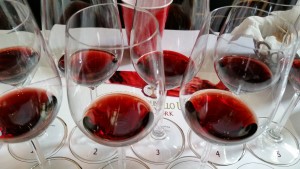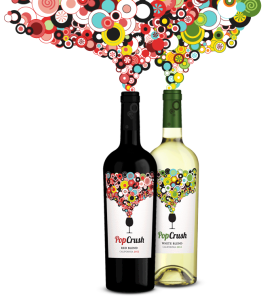Interested to experience the wines at this event, as I arrived the first thing I noticed was the heady scent of…cedar mulch. And the chirping of crickets. And the bright blooms of tulips and azaleas: I was at the Boston Flower and Garden Show.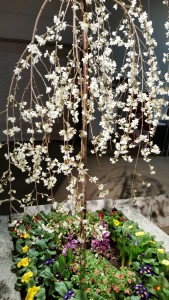
Having left my house in mid-March today with four-foot snowdrifts still guarding the driveway, I was thrilled find myself suddenly transported to the middle of May at this exhibition.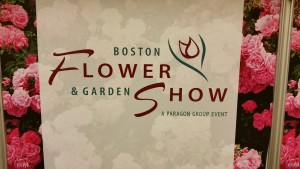
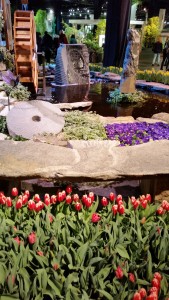 With all these blooms, it took some time for me to tear myself away and go over to the wine sampling area. Remember when Boston was too Puritanical to think about alcohol at public events? Luckily, that’s over. In fact, Pop Crush California wines and a Rosatello Italian sparklerare actually sponsors of the show this year. And they gave out samples. The Pop Crush red was fine, the white a bit sweet, in a popular way – acidified but pleasant. The light sparkling Rosatello rose turned out to be “partially fermented†which I hope meant that the sweetness was natural. (No reps for the wines were there to ask.)
With all these blooms, it took some time for me to tear myself away and go over to the wine sampling area. Remember when Boston was too Puritanical to think about alcohol at public events? Luckily, that’s over. In fact, Pop Crush California wines and a Rosatello Italian sparklerare actually sponsors of the show this year. And they gave out samples. The Pop Crush red was fine, the white a bit sweet, in a popular way – acidified but pleasant. The light sparkling Rosatello rose turned out to be “partially fermented†which I hope meant that the sweetness was natural. (No reps for the wines were there to ask.)
Given the venue, I think these should be easy to sip while discussing flowers and gardens with friends. Wine by the glass is for sale at concession stands, but I’m not sure if you can wander around the exhibits with a glass of wine at the show…yet.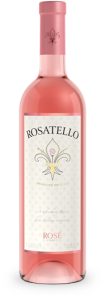
Blog
Blind Date Wine: Falling in Love with the Other One
So I go to a wine dinner to meet a new winemaker who specializes in red wines, and I end up falling in love with a white…
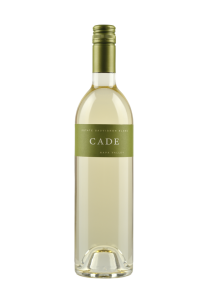
Invited to taste some of the mega-hip Plumpjack Group wines, at the mega-famous Ming Tsai’s Blue Ginger Restaurant, I was nevertheless cursing the whole event while driving there: it was dark, I was late, the streets were slippery, the roadside snowbanks too massive for on-street parking. The temperature was in the single digits when I stepped out of the car and tried to glide along the ice-sheeted pavement to the restaurant without a major casualty.
Everyone stared at me while I was being seated because Chef Ming had already begun speaking. Luckily he has a magnetic personality and all of our attention was drawn right back to him. Ming was shining brightly that night: relaxed, amusing and enjoying the evening — while giving brief but well-though-out descriptions of the complementary and contrasting flavors of dishes he had created to go with the wines.
Sometimes it’s more fun to taste and sip without analyzing what you’re eating and drinking; unfortunately I rarely get to do this. Except this time. As soon as I had made notes on the first wine, I started eating without consulting the menu. And was amazed at the complementary flavors here – in a dish I normally don’t order: ceviche. This was Grapefruit-Scallop Ceviche with Crispy Rice Cucumber Salad, extremely well matched with the 2013 CADE Sauvignon Blanc. The wine had tart citrus notes (grapefruit) and it was overall a great balance of florals, fruits and fresh herbs in both aromas and flavors.

Then I turned to my right to talk to the winemaker, who turned out to be very friendly and casual, despite his accolades. Jeff Owens, founding winemaker at Odette Winery, is the first winemaker to have a debut wine scored 100 points by prominent critic Robert Parker. Odette Winery is owned by the prominent Plumpjack Group: partners Gordon Getty, Gavin Newsom and John Conover, who also have Plumpjack and CADE wineries as well as several hotels and restaurants. (This prestigious group is also known for innovation in products, design and green initiatives.)
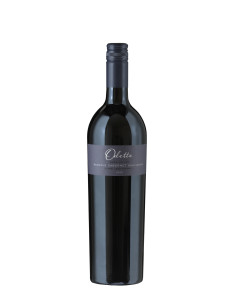
Winemaker Owens’ 100-point wine was the Odette Reserve Cabernet, which we did not taste this night, apparently because the new vintage won’t be released till September. Owens had worked at both CADE and Plumpjack Wineries before helping to found Odette, and we did taste the 2013 Plumpjack Napa Valley Reserve Chardonnay (not my favorite), as well as the 2012 Plumpjack Napa Valley Merlot, full of good, juicy dark berry fruit and soft tannins. Owen’s “regular†2012 Odette Estate Cabernet Sauvignon — which retails around $100, not $300 like the reserve — had big, very sweet fruit and soft tannins. It’s 75% cabernet sauvignon, 11% cabernet franc and 14% merlot. With elements ranging from red berries to minerality and good acidity, I found it paired best with the cheese course.
Unfortunately, by that time I was limited to the tiniest sips because I knew I’d have to drive home once dessert was over. Orange Cream Cake with Citrus Gastrique and White Chocolate Panko bookended the meal nicely, recalling the grapefruit flavors in the first course. It energized me nicely for the icy walk to my car. And it reminded me how much I liked the CADE Sauvignon Blanc.
The Tipping Point for Indian Liqueur: Somrus
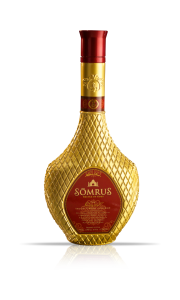 Days of craving Indian food hit the tipping point with the arrival of a golden bottle of Somrus Indian cream liqueur. The bottle shape is suggestive of Asia, and the glass itself looks quilted with gold.
Days of craving Indian food hit the tipping point with the arrival of a golden bottle of Somrus Indian cream liqueur. The bottle shape is suggestive of Asia, and the glass itself looks quilted with gold.
That evening we went to pick up several dishes at the closest Indian bistro – luckily barely a mile away, as a major snowstorm was beginning. When we returned home, I poured out tastes of Somrus over ice. Cardamom and rosewater dominated the aromas, with toffee butter rum following onto the palate, along with rich cream flavoring.
Again, cardamom and earthiness appeared in the end palate: perhaps that was the touch of almonds, pistachio and saffron mentioned on the label?
We served out the food and added more ice and liqueur to our glasses, and the spices in the liqueur paired very nicely with the flavors in the various dishes. Also, any too-spicy foods were nicely tamed by the cream liqueur. After I while, I noticed that no one seemed to be feeling much alcohol influence so I checked the label: though Somrus contains “Carribean rum†the alcohol content is only 13.5%!
Sweetly Enticing: Montalcino’s Golden Wines
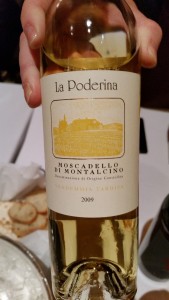 Did you realize that until a few decades ago, many people sought out great sweet wines in the little Tuscan town of Montalcino – which is now known as home of the powerful DOCG red wine Brunello di Montalcino? In fact, there are a couple DOC categories for these wines: Moscadello di Montalcino and Sant’Antimo Vin Santo.
Did you realize that until a few decades ago, many people sought out great sweet wines in the little Tuscan town of Montalcino – which is now known as home of the powerful DOCG red wine Brunello di Montalcino? In fact, there are a couple DOC categories for these wines: Moscadello di Montalcino and Sant’Antimo Vin Santo.
Though I think they keep most of these golden wines for themselves nowadays, I found several wonderful ones to taste at the Brunello producers’ recent New York tasting. (There were a few more, but I only managed to sample three.)
La Poderina’s 2009 Moscadello di Montalcino was so intensely apricot, so well balanced with great acidity I might have pegged it as a classic Sauternes.
Banfi’s 2012 Moscadello di Montalcino, true to its “Florus†name, was both floral and sweet – still young.
Il Poggione brought their current vin santo: a decade old! Their 2004 Sant’Antimo DOC Vin Santo was so intense and even raisiny it reminded me of well-made Pedro Ximenez sherry – and I say that as a compliment.
New Spanish -Danish Wines
So, a number of years ago, this Danish guy’s wife got a job as a dentist in Valencia and the couple moved to Spain. The guy discovered wines made from traditionally farmed “bush vines†(not trained on modern wire trellises) and he was hooked. He sought out the old vineyards and hired several winemakers to work in these areas. 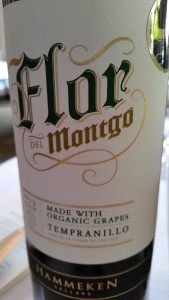
Today, Nicholas Hammeken’s company produces wine from about 40% old vines (30+ years) – and they are even starting to see a few farmers returning their vineyards to bush vine plantings. Especially in areas where people had tried out “international†varieties but discovered that traditional Spanish grapes like garnacha and tempranillo do much better.
This year, after exporting to 40 other countries, some of the Hammeken wines are finally available in the US. Hammeken Cellars now produces 1.5 million cases of wine, from more than 20 Spanish wine regions.
At a tasting the other day I was pretty impressed with several of the wines I sampled. To start, a very nice cava from the traditional Penedes region: 2013 Picos del Montgó Cava, which was layered and well balanced, with medium small bubbles, nice acidity, classic notes of toast and yeast, with some lemon and apricot flavors too.
I particularly liked the 2012 Montgó Garnacha (DOP Carignena, $16.99): 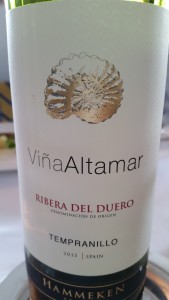 clear, dark ruby red, with good acidity and spice notes that complemented Middle Eastern/Mediterranean foods like chick peas, garlic sausage and other tasty bites with Moroccan style spices.
clear, dark ruby red, with good acidity and spice notes that complemented Middle Eastern/Mediterranean foods like chick peas, garlic sausage and other tasty bites with Moroccan style spices.
Though the Hammeken does have some more pricy wines in the US this year, a couple moderate product lines make it easy to identify the company’s other wines on a shelf. Viña Altamar ($14.99) wines have a gold fossil on the label, reflecting the fossilized former seabeds where the Rueda and Ribera del Duero wines are grown. Then there’s a fun retro-label Radio Boca (Radio Mouth) line with fruit-forward tempranillo and other wines for casual quaffing at $8.99.
The company is also looking toward organic wines, with a Flor del Montgó Organic Tempranillo ($13.99), with nicely integrated tannins and a plenty of plummy fruit. Great with chicken – especially at L’Espalier!
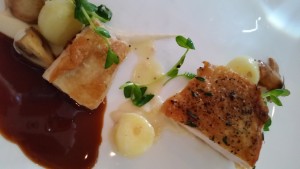
Powerful red wines from a tiny town: Brunello di Montalcino
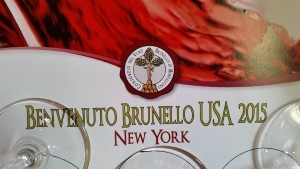
Since the hilltop town of Montalcino is not easy to get to, it’s a good thing that the producers of Brunello di Montalcino bring their wines to the US for tastings. We do consume a quarter of the complex mahogany red wine they produce. Brunello is full of dark cherry flavors with additional notes that range from earthiness and cigars to anise and mint. There is elegance as well as power in these wines.
Can you tell I like Brunello? It won my heart a few years ago when I was plunked down in my first tasting of dozens of new Brunellos, and I inhaled the characteristic violet aromas of the new wines. Which then morphs into darker cherry and other complex flavors and aromas, equally charming. Of course the picturesque village and the festive atmosphere helped: this was Benvenuto Brunello, the annual February celebration of the release of the latest vintage of Brunello di Montalcino DOCG: in the fifth year after harvest.
This week in New York we tasted the newly released 2010 vintage. And 2010 being one of the top years of the past decade, it’s clear this vintage will continue to evolve and be a delight to drink for many years – even decades to come. The wines have plenty of fruit, tannin and acidity, and a structure guarantees ageability in the wines. You might think that these wines would cost a fortune, but many of these powerful, world-class reds retail for as little as $45 a bottle.
Many of my favorites were there: Banfi, Lisini, Talenti, Val di Suga, and though I didn’t manage to taste them all, some really stood out in the crowd: Camigliano, Col d’Orcia, La Poderina. And Voliero, which made me long for a meal to accompany it. Which reminds me that these are great food wines, especially with the simple cuisine of the Tuscan hillsides from back in the day: pasta and stews with grains and vegetables, until someone caught a rabbit or a wild boar to add to the table.
